Greece › Naxos Travel Guide
Updated: December 4, 2025 • By Santorini Dave
Popular Pages
• Best Naxos Towns
• Best Naxos Hotels
• Best Hotels for Families
• Best Beach Hotels
• Best Naxos Beaches
• Athens to Naxos Ferry
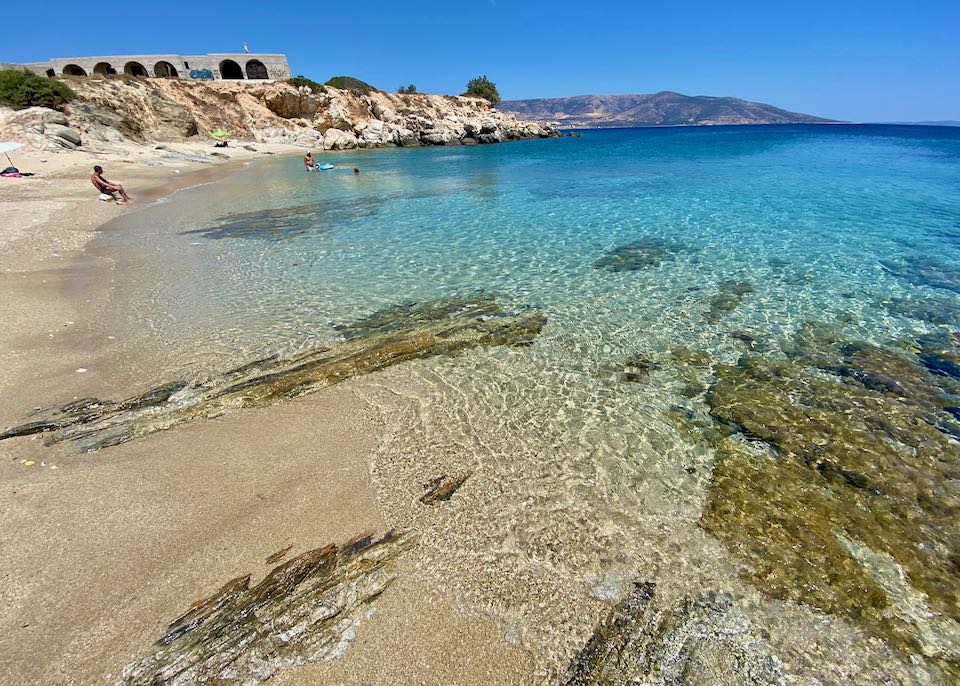
Naxos has some of the best beaches in Greece. Most are easily accessible by bus from Naxos Town.
Naxos is the largest and greenest island in the Cyclades. Known as the agricultural heart of the archipelago, it offers a refreshing contrast to its famous neighbors: instead of glitz and crowds, you find incredible farm-to-table food, lower prices, and a grounded, authentic vibe. The island is ringed by miles of soft, sandy beaches (my favorite for beaches in Greece), while the mountainous interior is peppered with olive groves, ancient Byzantine churches, and traditional villages like Halki and Apiranthos. Located conveniently between Santorini and Mykonos (both have international airports so you can fly into one island, and out of the other), Naxos is the perfect place to slow down and experience the real Greece.
My 2026 Naxos Travel Guide
- Skip to our Naxos FAQ
My wife and I at To Spitiko, our favorite place for gyros in Naxos.
Naxos Basics
- Where to Stay in Naxos
- Best Time to Visit Naxos
- Naxos or Paros?
- Naxos Travel Videos
- Naxos Travel Maps
Naxos Hotels
Naxos Activities and Attractions
Naxos Trip Planning
- Getting Around Naxos by Bus
- Santorini to Naxos Ferry
- Naxos to Santorini Ferry
- Athens to Naxos Ferry
- Naxos to Athens Ferry
Latest Articles & My Travel Newsletter
Frequently Asked Questions about Naxos
See Also: Greece: Tips & Information for First-Timers
How Many Days Should I Stay in Naxos?
Naxos is the largest island in the Cyclades. It is significantly bigger than Santorini or Mykonos, and its attractions—mountain villages, ancient ruins, and endless beaches—are spread out. You cannot see Naxos quickly.
The Short Answer: Plan for 4 to 5 days. This allows you to combine beach time with a rental car road trip to the interior, which is the soul of the island.
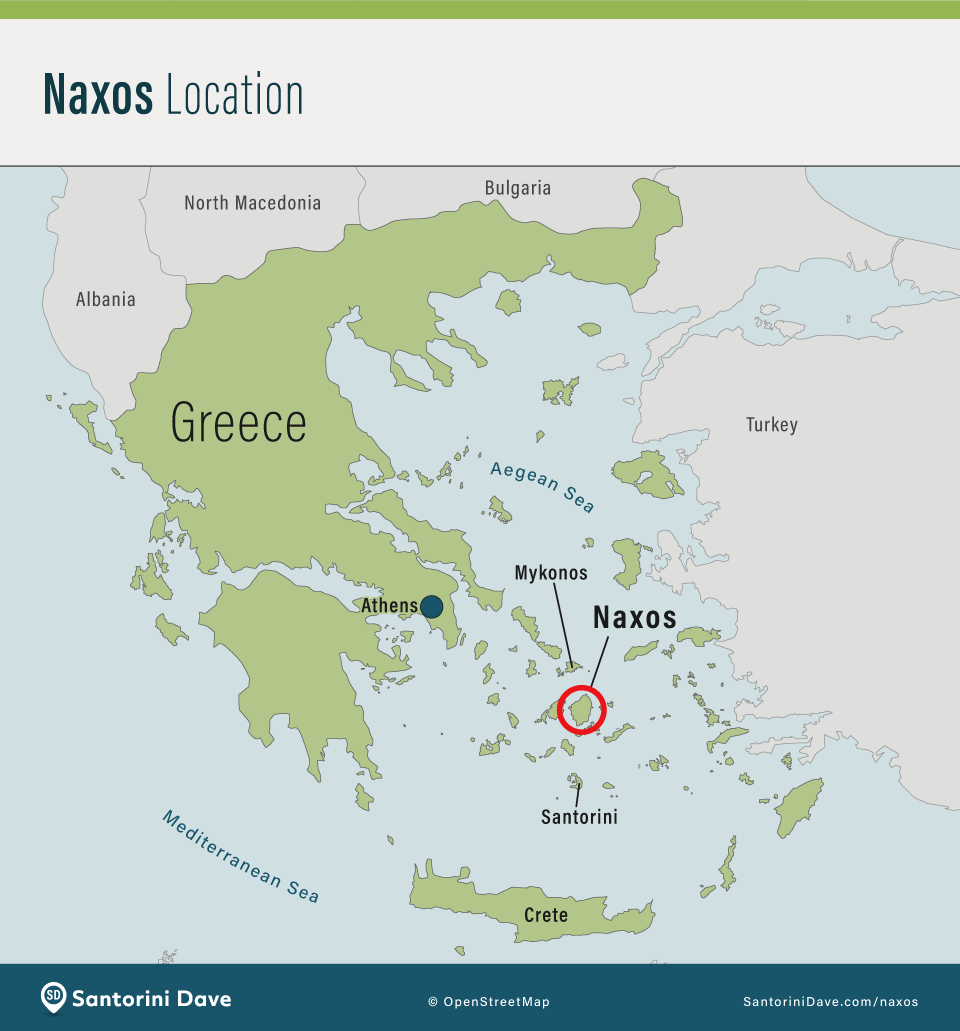
3 Days (4 Nights): The Essentials
If you are island hopping and short on time, 3 full days is enough to see the main highlights.
- Day 1: Explore Naxos Town (Chora). Wander the Old Market, hike up to the Venetian Castle (Kastro), and watch the sunset at the Portara (Temple of Apollo).
- Day 2: Beach Day. Head to the famous golden sands of Agios Prokopios or Plaka.
- Day 3: Rent a car for a mountain road trip. Visit the Kitron distillery in Halki, the marble village of Apiranthos, and the Temple of Demeter.
5 Days (6 Nights): The Sweet Spot
With 5 days, you can actually experience the diversity of the island without rushing.
- Hiking: You have time to hike Mount Zas (the highest peak in the Cyclades) or the easier trail to the Apano Kastro.
- Boat Tours: Take a day cruise to the stunning Small Cyclades (Koufonisia or Iraklia) or a catamaran swim cruise to Rina Cave.
- Food: You can dine in the mountain tavernas of Filoti or Koronos, famous for their local lamb and cheese, which is a totally different experience than the seaside tourist restaurants.
7 Days (8 Nights): The Deep Dive
Naxos is one of the few islands where a week does not feel too long.
- Hidden Beaches: Drive south to the wild, cedar-forest beaches of Alyko and Hawaii.
- The North: Take a road trip to the northern tip to see the giant Kouros statue of Apollonas and have lunch in the quiet fishing village there.
- Relaxation: You can spend full days lounging at beach clubs without feeling guilty about missing sightseeing.
Why you shouldn’t stay for just 2 nights:
Naxos is not a “stopover” island. It is an agricultural hub with a rich interior life. With only 2 nights (1 full day), you will likely get stuck in Naxos Town and maybe see one beach. You will miss the mountain villages, the ancient statues, and the incredible food scene in the interior.
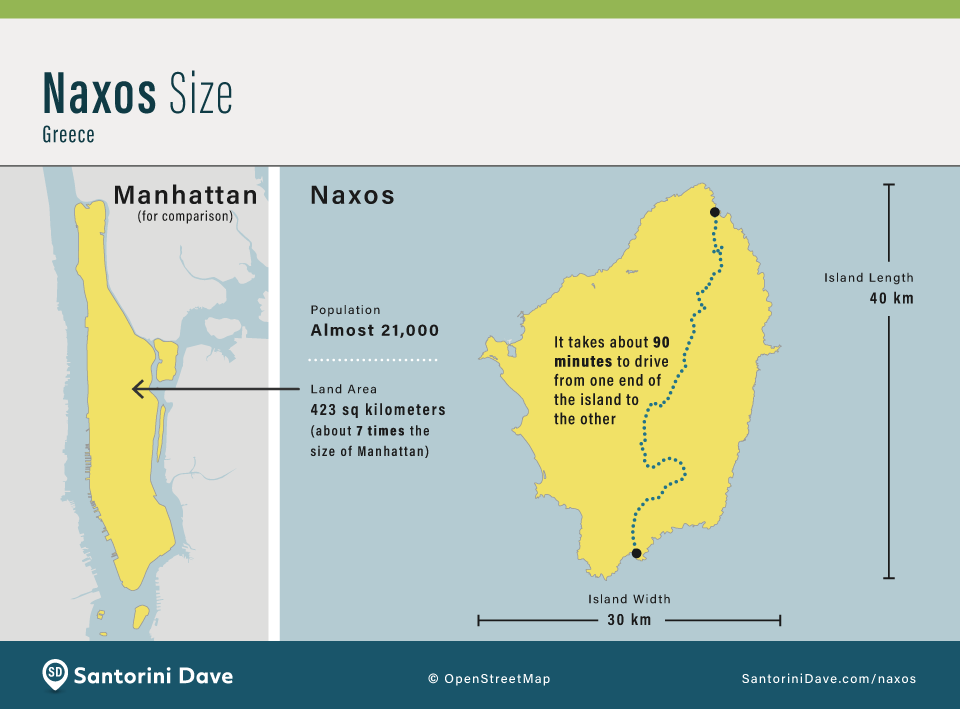
How big is Naxos?
Naxos is a substantial island with a year-round population of nearly 21,000. Covering 430 square kilometers, it is roughly seven times the size of Manhattan (or one-quarter the size of Maui). The island measures about 40 km long by 30 km wide; expect a drive from one end to the other to take approximately 90 minutes.
The view of Agios Georgios Beach from our room at Kalergis Hotel in Naxos Town.
What’s the easiest way to get to Naxos – fly or ferry?
The “easiest” choice depends entirely on where you are starting your journey. Unlike Mykonos or Santorini, Naxos does not have an international airport, which changes the strategy.
Fly to Naxos if…
- You are already at Athens Airport: If you are landing at Athens International Airport, a 40-minute connecting flight is much faster and easier than taking a taxi to the ferry port.
- You get seasick: The Aegean can be windy (especially in July/August), and high-speed ferries can be bumpy. Flying avoids this completely.
- You book early: Naxos has a very small airport that only takes small propeller planes (ATR-42/72). Seats are limited and sell out months in advance during summer.
Take the Ferry to Naxos if…
- You are in Athens City Center: It’s easier to take the Metro to Piraeus Port than to trek back out to the airport. Naxos is a major hub, so ferry connections are frequent and reliable.
- You are Island Hopping: If coming from Santorini, Mykonos, or Paros, the ferry is your standard option. Naxos is centrally located, making trips short.
- You have heavy luggage: The small planes to Naxos have stricter overhead bin limits than larger jets. Ferries have no weight limits and no extra fees for bags.
- You want the scenic route: Conventional ferries (like Blue Star) allow you to sit on the open deck and enjoy the sea, which you cannot do on a plane or a high-speed ferry.
My wife and I arriving in Naxos by ferry.
How Long is the Ferry Ride?
Ferry times vary by vessel type (High-Speed vs. Conventional):
- From Piraeus (Athens): 3.5 hours (High-Speed) to 5.5 hours (Blue Star).
- From Rafina (Near Airport): 4 to 6 hours. Rafina is a good option if you land at the airport but prefer the ferry, though it’s further from Naxos than it is from Mykonos.
- From Santorini: 1.5 hours (High-Speed) to 2.5 hours (Blue Star).
- From Mykonos/Paros: 35 minutes to 1 hour.
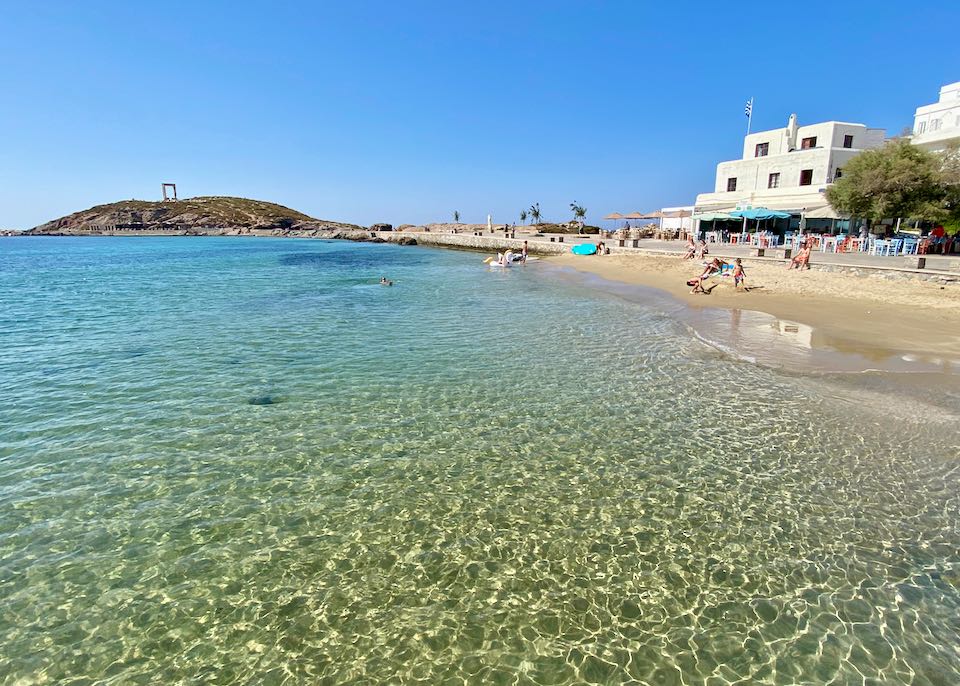
The marble Portara (gate) of the Temple of Apollo at Naxos Harbor dates back to the 6th century BC and is visible from the ferry pier.
What is the best month to visit Naxos?
Naxos is more than just a beach destination; it’s an island of mountains, agriculture, and year-round local life. The best time to visit depends on whether you prioritize beach weather, windsurfing, or hiking and culture.
High Season: July & August (The Family Peak)
- The Vibe: Bustling but less frantic than Mykonos or Santorini. Naxos is a favorite for families, so the vibe is lively and cheerful. Restaurants in Chora and the beach towns (Agios Prokopios, Plaka) are busy every night.
- Weather: Hot (30°C+) and windy. The Meltemi winds are strongest in August.
- Good news: It keeps the heat manageable.
- Great news: It makes Naxos a world-class destination for windsurfing and kitesurfing (especially at Mikri Vigla).
- Crowds: Accommodation fills up fast, and you will need reservations for rental cars (essential for exploring). However, the island is huge, so you can always find a quiet spot in the interior.
Shoulder Season: June & September (The Sweet Spot)
- The Vibe: Ideal. The island is fully open, but the peak family crowds have not arrived (June) or have just left (September). It feels relaxed and authentic.
- Weather: Near perfection.
- June: The landscape is still green from spring, making the mountain drives stunning.
- September: The sea is at its warmest after heating up all summer, and the winds usually calm down.
- Value: Excellent. You get the full summer experience with better hotel rates and easier restaurant reservations.
Low Shoulder: May & October (Hiking & Culture)
- The Vibe: Peaceful. These are the best months for hiking Mount Zas or exploring the marble village of Apiranthos without heatstroke.
- Swimming: A mixed bag. May is brisk (19°C) and refreshing. October is often warm enough for swimming until mid-month. Beach bars begin opening in May and closing in October.
Low Season: November to April (Local Life)
- The Reality: Unlike smaller islands, Naxos has a large permanent population (~20,000). While the beach resorts (Plaka/Prokopios) shut down completely, Naxos Town (Chora) remains lively with open cafes, shops, and tavernas catering to locals. It’s a fantastic time for an authentic, cultural trip, though ferry schedules are reduced and it is too cold for the beach.
My Recommendation:
For the perfect mix of warm swimming water, manageable winds, and local harvest vibes (Naxos is famous for its potatoes and cheese), September is my single favorite month to visit.Some of the oldest Byzantine churches in Greece are found throughout the Naxos countryside.
What is the history of Naxos?
Naxos has a rich history that spans from ancient mythology to its status as a Venetian stronghold.
Mythology: The Island of Zeus and Dionysus
According to myth, Zeus, the king of the gods, was raised in a cave on Mount Zas (the highest peak in the Cyclades) to hide from his father Cronos. His son, Dionysus (god of wine and revelry), was also raised here and loved the island so much that he blessed it with fertility and vineyards. This is also where Theseus abandoned Ariadne after escaping the Minotaur; Dionysus found her, fell in love, and married her.Ancient & Byzantine History
Inhabited since 4000 B.C., Naxos was the center of the ancient Cycladic civilization. The massive marble Portara (Gate of Apollo), dating to 530 B.C., stands as a testament to its ancient wealth. Later, Naxos became a significant religious center. It boasts the oldest Byzantine churches in Greece, including the 6th-century monastery Christ Photodotis and the 7th-century Panagia Drosiani. Today, over 200 Byzantine churches dot the countryside.The Venetian Era (The Duchy of the Archipelago)
In 1207, the Venetian Marco Sanudo captured the island and established the Duchy of the Archipelago, making Naxos its capital. This era defined the island’s architecture. The Venetians built the fortified Kastro in Naxos Town and the distinctive “Tower Houses” scattered throughout the interior to protect the fertile lands from pirates. The Venetians ruled for over 300 years, leaving a Catholic influence that remains today.WWII and The Rise of Tourism
Naxos joined the independent Greek state in 1832. During World War II, the island was occupied first by the Italians (1941–1943) and then by the Germans (1943–1944). The island suffered from famine and isolation, but the mountainous terrain allowed for a strong local resistance movement that aided Allied forces. Unlike its neighbors Mykonos and Santorini, which embraced mass tourism in the 1960s and 70s, Naxos remained an agricultural powerhouse (famous for potatoes, cheese, and emery mining) well into the late 20th century. Tourism only became the primary industry in the last two decades. This delay saved Naxos from overdevelopment, preserving the authentic village life and agriculture that make it so special today.
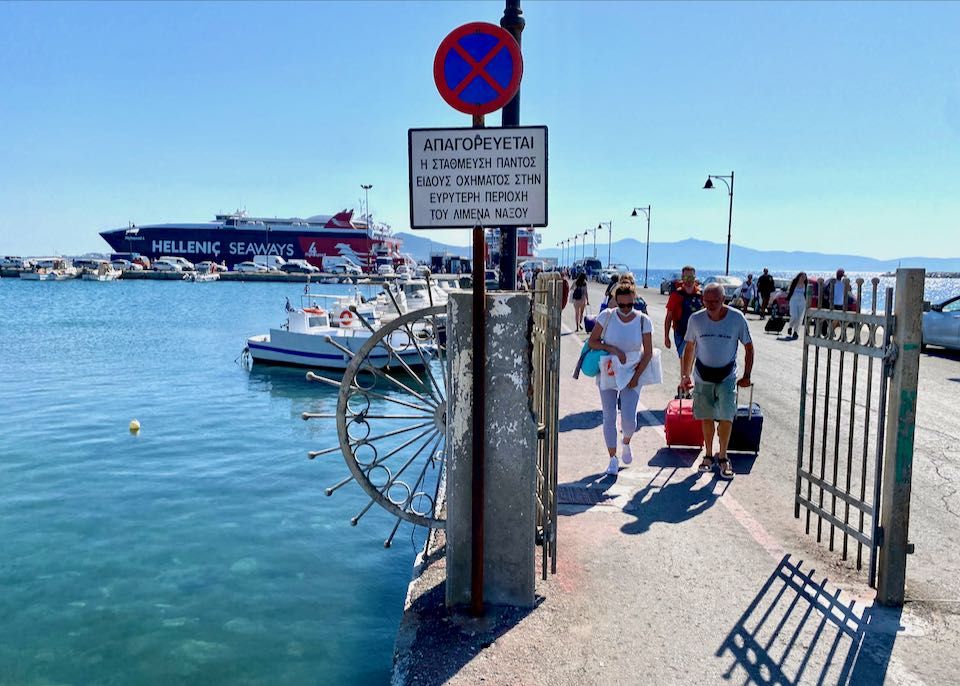
The ferry port in Naxos Town is an easy walk to the center of town and many hotels. Hotels at St George’s Beach might be too far to walk if you have more than a backpack.
What is the best way to get around Naxos island?
Naxos is the largest of the Cyclades, so getting around requires a different strategy than on smaller islands. While you can stick to the main beaches by bus, the true magic of Naxos lies in its mountain villages and hidden coves, which are best explored by car.
Public Bus (KTEL): The bus system on Naxos is excellent, reliable, and covers the main tourist areas well.
- The Hub: The central bus station is located directly at the end of the ferry port pier in Naxos Town (Chora). You cannot miss it.
- Key Routes: Line 1 is the “Beach Bus,” running frequently (every 30 mins in summer) from the port to the popular west coast beaches: Agios Prokopios, Agia Anna, and Plaka. Other reliable routes head to the inland villages of Halki, Filoti, and Apiranthos.
- Pros: Extremely cheap (€2–€5) and comfortable. It’s the best way to get to the beach without worrying about parking.
- Cons: Routes to the far north (Apollonas) or south (Panormos) are infrequent. You are tied to the schedule.
- Tickets: You must buy tickets before you board at the ticket office at the port or small shops. You cannot pay the driver.
Rental Car: Highly recommended for at least part of your trip.
- Why rent? Naxos is big. To see the marble village of Apiranthos, the Temple of Demeter, or the wild beaches of Hawaii/Alyko, a car is essential. It gives you the freedom to explore the stunning interior.
- Pros: Freedom, air conditioning, and access to the best tavernas in the mountains. Driving in Naxos is generally easier than on Santorini or Mykonos as the roads are wider and less congested (once you are out of town).
- Cons: Parking in Naxos Town is difficult in high season. There are large municipal lots on the outskirts, but they fill up.
- Tip: Rent a small car. The village streets can be very narrow.
Taxis: Useful but limited.
- Availability: There is a main taxi rank at the port and another at the airport. In July and August, there can be a shortage, so booking in advance or being patient is key.
- Cost: A ride from the port to Plaka Beach costs around €25–€30. To the airport is about €15–€20.
- Best For: Airport transfers or getting back to your hotel late at night after the buses stop.
From Naxos Airport (JNX):
- Bus: There is no direct bus from the airport terminal. You must walk about 10 minutes out to the main road to catch the bus coming from the beaches into town. It is not convenient with luggage.
- Taxi: The best option. The ride to Naxos Town or Agios Prokopios takes only 10–15 minutes.
- Transfer: Highly recommended. Book a Welcome Pickup or arrange a transfer through your hotel to have a driver waiting for you.
From the Ferry Port (Naxos Town):
- Walk: If staying in Naxos Town (Chora) or St. George Beach, you can likely walk to your hotel (5–15 minutes).
- Bus: The bus station is right at the end of the ferry pier. It’s the easiest transfer to the beach towns (Prokopios/Agia Anna/Plaka).
- Taxi: The taxi rank is located on the main waterfront road, just to the right as you exit the pier.
My Recommendation:
Use the bus for your beach days (it’s easy and cheap). Rent a car for 2 or 3 days to do a road trip loop of the mountain villages (Halki, Filoti, Apiranthos) and the northern coast. This gives you the perfect balance of relaxation and exploration.
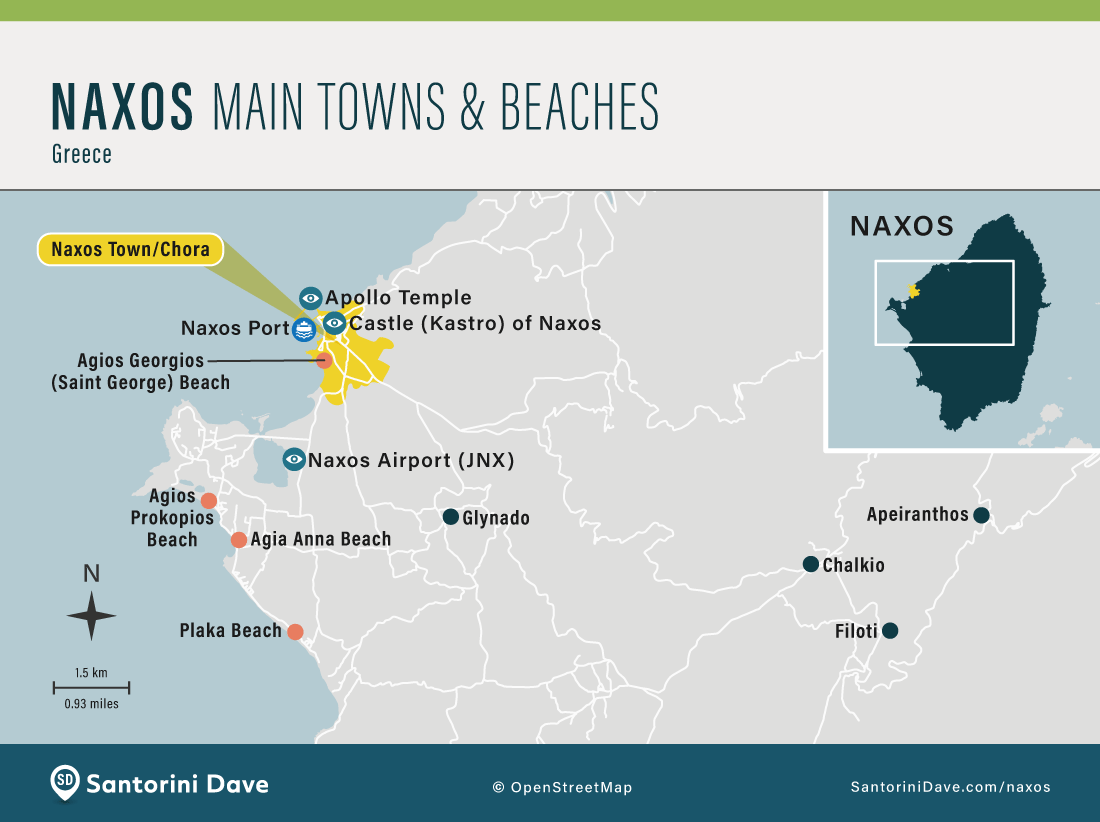
What are the main towns on Naxos?
Naxos has a distinct split personality: the bustling port capital and the traditional mountain villages.
Naxos Town (Chora)
This is the island’s capital and main port. It’s where the vast majority of visitors stay. It features the iconic Portara (Temple of Apollo) and a stunning hilltop Venetian Kastro surrounded by a maze of narrow alleys (the Old Market) filled with shops and tavernas. It is the transportation hub for all ferries and buses. The family-friendly Agios Georgios (St. George) Beach is just a short walk from the center.The Mountain Villages
The interior of Naxos is the most authentic in the Cyclades.
- Halki (Chalki): The former capital. A charming village of neoclassical mansions, art galleries, and the famous Vallindras Kitron distillery.
- Filoti: The largest mountain village, situated at the base of Mount Zas. It has a lively main square lined with cafes and tavernas under giant plane trees.
- Apiranthos: The “Marble Village.” Famous for its marble-paved streets and distinct Cretan dialect.
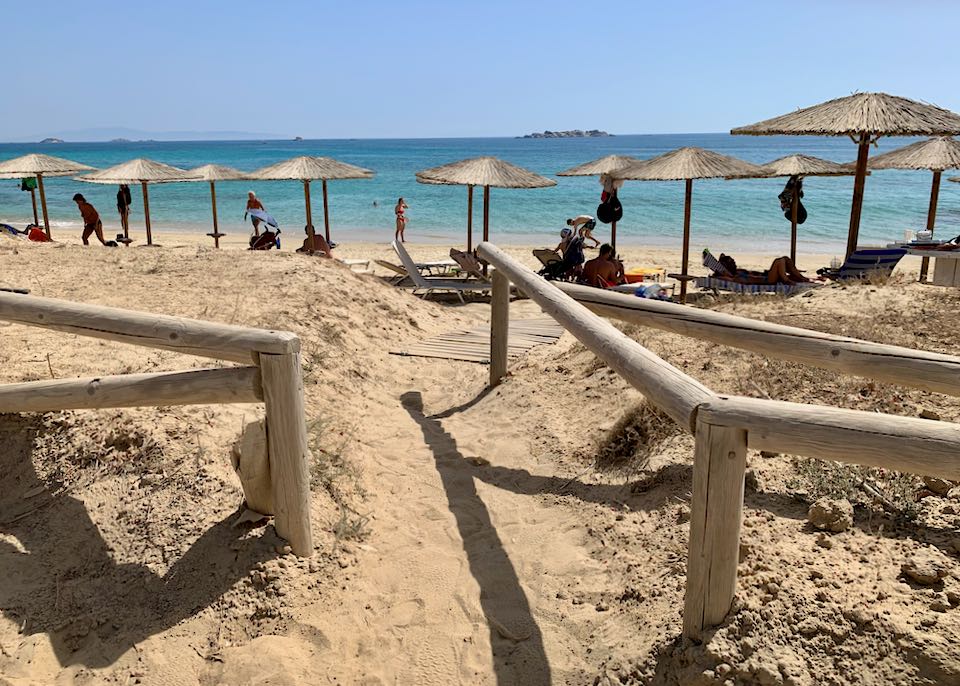
The golden sand and turquoise water of Plaka Beach in Naxos, Greece.
What are the best beaches on Naxos?
Naxos’ beaches are my favorite in Greece. The most popular run along the sheltered southwest coast.
- Best for Families: Agios Georgios (St. George) (shallow, in town) and Agios Prokopios (thick golden sand, protected from wind).
- Best for Swimming: Agia Anna and Plaka. Agia Anna is a picturesque continuation of Prokopios with a small fishing port. Plaka is a massive, endless stretch of golden sand and dunes that never feels crowded.
- Best for Nature: Alyko and Hawaii Beach. Located in the south, these are undeveloped coves backed by a protected cedar forest.
- Best for Watersports: Mikri Vigla. A world-class spot for kitesurfing and windsurfing.
Where is the best place to stay in Naxos?
For most travelers, the best places to stay in Naxos are Naxos Town (Chora) or the adjacent Agios Georgios Beach. Staying here gives you the best of both worlds: a great beach by day and a lively town with endless dining options by night, all without needing a car.
If you prefer a pure beach holiday, stay in Agios Prokopios or Agia Anna. These are resort towns with excellent beaches and plenty of tavernas, connected to town by frequent buses. For a quieter, more romantic escape, choose Plaka. Only stay in the mountain villages if you have a rental car and prioritize hiking and silence over the sea.
What are the best things to do in Naxos?
Naxos offers a rich mix of history, nature, and island life. Here are the absolute must-dos:
- Walk to the Portara: The massive marble gate of the unfinished Temple of Apollo stands on an islet at the harbor entrance. It is the iconic symbol of Naxos and the single best spot for sunset.
- Explore the Old Market & Kastro: Get lost in the winding, covered alleyways of Naxos Town (Chora). Climb up to the medieval Venetian Castle (Kastro) at the summit for history and panoramic views.
- Beach Hopping: Swim at the crystal-clear waters of Agios Prokopios or find your own space on the endless golden sands of Plaka. For windsurfing, head to Mikri Vigla.
- Visit the Mountain Villages: Rent a car and drive inland.
- Halki: Visit the historic Vallindras Kitron Distillery to taste the local citron liqueur.
- Apiranthos: The “Marble Village,” famous for its marble-paved streets and architecture.
- See the Temple of Demeter: A stunning, partially restored ancient temple in the middle of the countryside (near Sangri). It dates back to 530 BC.
- Find the Kouros Statues: Hike to see the colossal, unfinished ancient marble statues lying in the quarries at Melanes or Apollonas.
- Hike Mount Zas: Climb to the summit of the highest peak in the Cyclades (1,004m). The views are incredible.
- Sunset Dinner at Rotunda: Drive up to the Rotunda Cafe (near Filoti) for a sunset dinner with one of the most spectacular mountain-to-sea views in Greece.
It’s easy to get happily lost in the tangle of shops and footpaths in Naxos Town.
What are the most romantic areas, beaches, and hotels for couples in Naxos?
Naxos is a fantastic choice for couples who want an authentic Greek experience without the pretense or price tag of Santorini. It offers incredible food, stunning sunsets, and plenty of privacy.
The Best Towns for Couples
- Naxos Town (Chora): The most romantic place to stay. The “Old Market” is a maze of covered alleys filled with candlelit tavernas and jazz bars. The sunset view from the Portara (Temple of Apollo) is iconic. Staying here means you can have a beach day and then a sophisticated night out without needing to drive.
- Plaka Beach: For a barefoot luxury vibe. It’s quieter than the other beach towns, with sand dunes and sunset dinners right on the water.
- Halki: For a day trip. It is a neoclassical village in the mountains with art galleries and the Kitron distillery. It feels like a step back in time.
The Most Romantic Beaches
- Plaka: Endless golden sand. It’s so long that you can always find a secluded spot away from the crowds. The sunset views over Paros are unbeatable.
- Hawaii Beach & Alyko: Located in the south, these are wild, undeveloped coves backed by a cedar forest. They offer privacy and natural beauty (no sunbeds, just nature).
- Agia Anna: A tiny fishing port with a cluster of excellent seafood tavernas right on the sand. Perfect for a long, lazy lunch.
Best Hotels for Couples
- 18 Grapes Hotel (Agios Prokopios): A luxury boutique hotel just a short walk from the best beach on the island. It has a stunning pool area and a very chic, adult atmosphere.
- Naxian Collection (Stelida): Luxury villas with private pools and high-end service. Famous for its food (Anthony Bourdain filmed here). It’s quiet and exclusive, perfect for honeymoons.
- Hotel Grotta (Naxos Town): The best value romantic hotel. It is perched on a cliff overlooking the Portara. The sunset view from the indoor pool and breakfast area is legendary. Hospitality is unmatched.
- Nissaki Beach (St. George Beach): The only true 5-star hotel right on the beach in Naxos Town. You can walk into the water in the morning and walk to the Old Market for dinner at night.
- ELaiolithos (Moni): For a unique mountain escape. Located in the center of the island with breathtaking views of the valleys. It’s eco-friendly, luxurious, and totally different from the beach hotels.
The charming stone pathways of Chalki village. A mountain hike from Moni to Chalki is recommended on trips longer than two days.
Should I rent a car on Naxos?
For most visitors, the answer is yes. Naxos is the largest Cycladic island, and while the beaches are great, the true soul of the island lies in the mountain villages and hidden landscapes that are hard to reach by bus.
- When you DON’T need a car: If you are staying in Naxos Town (Chora) or Agios Prokopios/Agia Anna for just 2 or 3 days and plan to stick to the main beaches. The bus system is excellent for this specific route, running frequently along the west coast. You can easily rely on buses and taxis.
- When you DO need a car: If you want to visit the mountain villages (Halki, Apiranthos), the northern tip (Apollonas), or the secluded southern beaches (Hawaii, Alyko). The bus service to the interior is infrequent and radial (meaning you often have to return to town to switch lines), which eats up your day. A car gives you the freedom to create your own loop.
Important Driving Tips:
- Rent Small: The roads in the mountain villages are ancient and incredibly narrow. Do not upgrade to a large SUV; you will regret it when trying to squeeze past a bus on a tight corner.
- Parking in Town: Parking in Naxos Town is difficult in high season. There are three large municipal lots on the outskirts. Use them and walk in; don’t try to drive into the center.
I recommend Booking.com for pre-booking. It compares all local and major agencies to find the best deal.
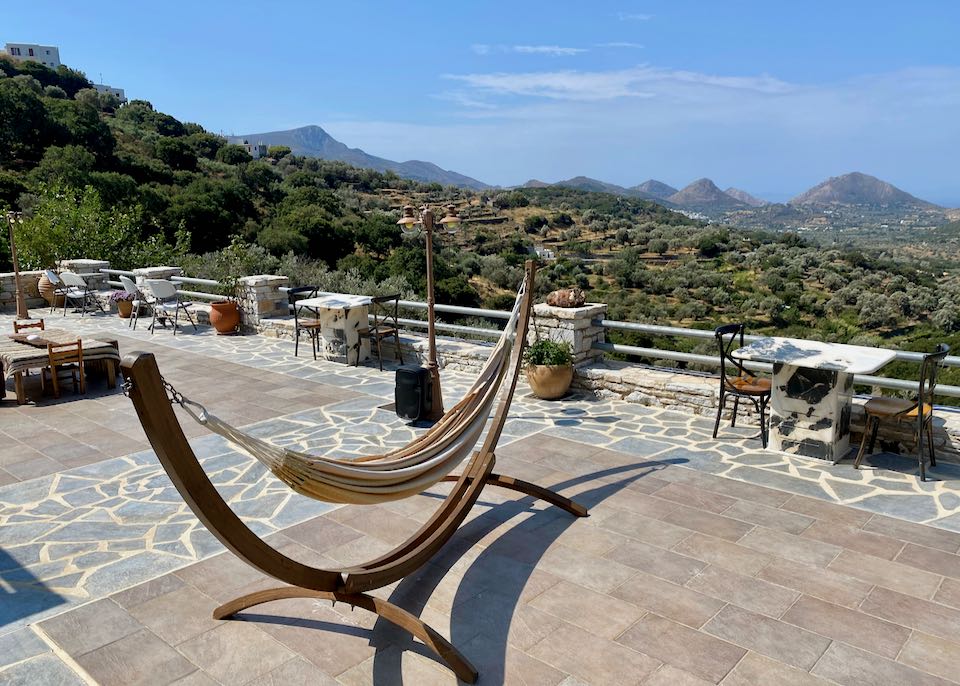
Buses on Naxos serve all the major beach towns, but much of the island’s scenic mountain countryside is only accessible by car. Pictured is the idyllic inland setting of ELaiolithos Luxury Villa Suites (Adults Only).
What currency is used in Naxos?
The currency is the Euro (€).
Cash vs. Credit Cards in Naxos
- Credit Cards: Widely accepted in Naxos Town (Chora) and the popular beach resorts like Agios Prokopios and Plaka. You can use Visa and Mastercard for almost all hotels, car rentals, and restaurant meals in these areas.
- When you need Cash: Naxos is more agricultural and traditional than Mykonos or Santorini. You will definitely need cash for:
• Mountain Villages: In traditional villages like Apiranthos, Filoti, and Halki, many small cafes, bakeries, and shops selling local products (like Kitron or cheese) prefer or require cash.
• The Bus: While you can pay by card at the main ticket office at the port, tickets bought on the bus or at village mini-markets are almost always cash-only.
• Beach Beds: At organized beach clubs, cards are fine. But for a simple set of beds on a quieter stretch of Plaka or Mikri Vigla, the collector often only takes cash.- ATMs: Plentiful in Naxos Town and the main beaches. Key mountain villages like Filoti and Halki usually have one ATM, but they can occasionally run out of cash, so stock up in Chora before heading inland.
Important Tip: Always Pay in Euros
When using your card, the machine will often ask: “Pay in EUR or [Your Home Currency]?” Always choose Euros. If you choose your home currency, the merchant’s bank applies a terrible exchange rate with hidden fees. Let your own bank handle the conversion.Most restaurants in Naxos Town, like the excellent Doukato, accept credit cards.
Is Naxos expensive?
Naxos offers incredible value compared to Mykonos and Santorini, but prices have risen in recent years. It is no longer a strictly “budget” destination, though it remains affordable if you plan well.
- Accommodation: You can still find excellent moderate hotels and studios for €80–€150 per night, even near the beach. Luxury hotels are increasing in price but typically cost 30-50% less than equivalent suites on Santorini.
- Beach Clubs: This has changed significantly. The “free sunbeds with a drink” model is disappearing from popular beaches like Agios Prokopios and Agia Anna. Expect to pay €20 to €40+ for a set of two loungers and an umbrella in high season. Free sunbeds can still be found, but usually only at quieter tavernas further south on Plaka or Kastraki.
- Dining: Extremely high quality for the price. Because Naxos produces its own meat, cheese, and vegetables, restaurant prices are reasonable and portions are generous.
- Resorts: There are virtually no large “all-inclusive” resorts. Naxos is about boutique hotels and family-run studios.
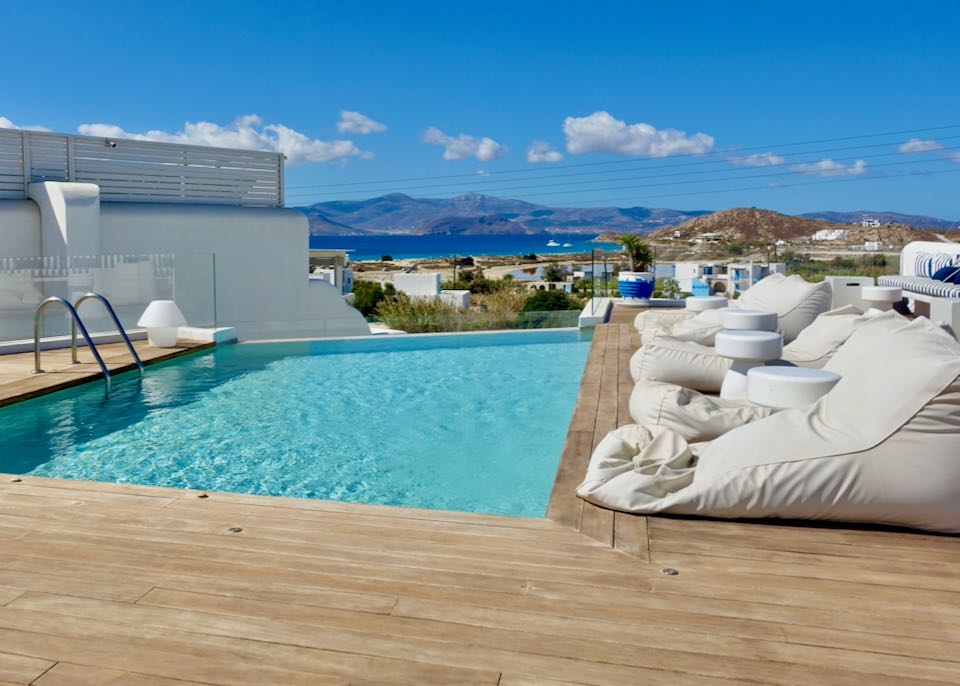
Even the best hotels, like 18 Grapes overlooking Agios Prokopios Beach, are blissfully affordable when compared to Santorini or Mykonos prices.

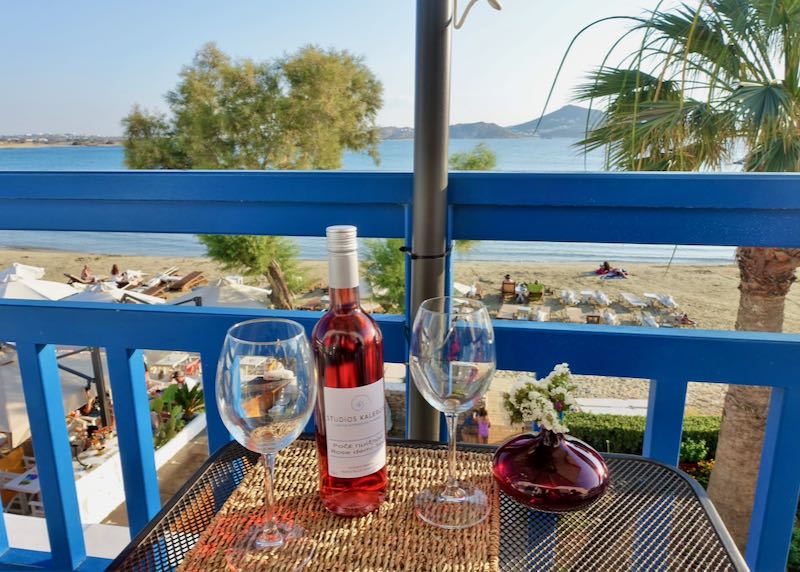
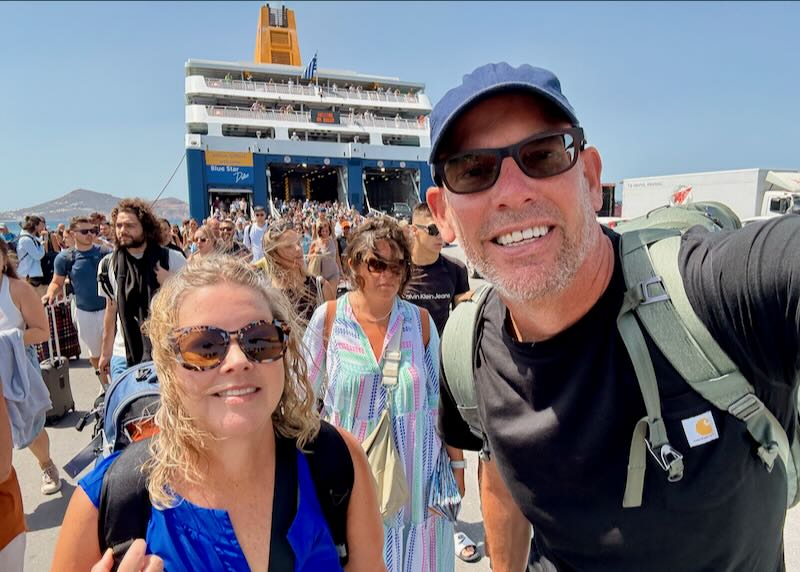

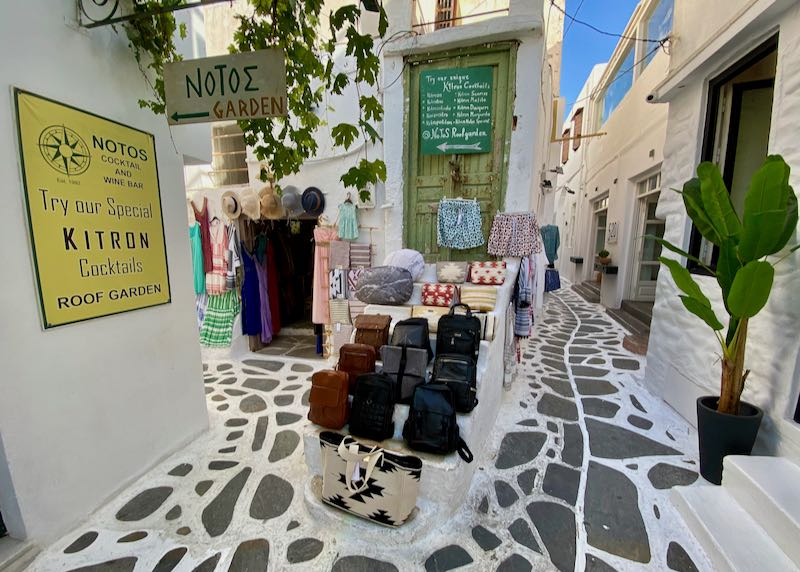
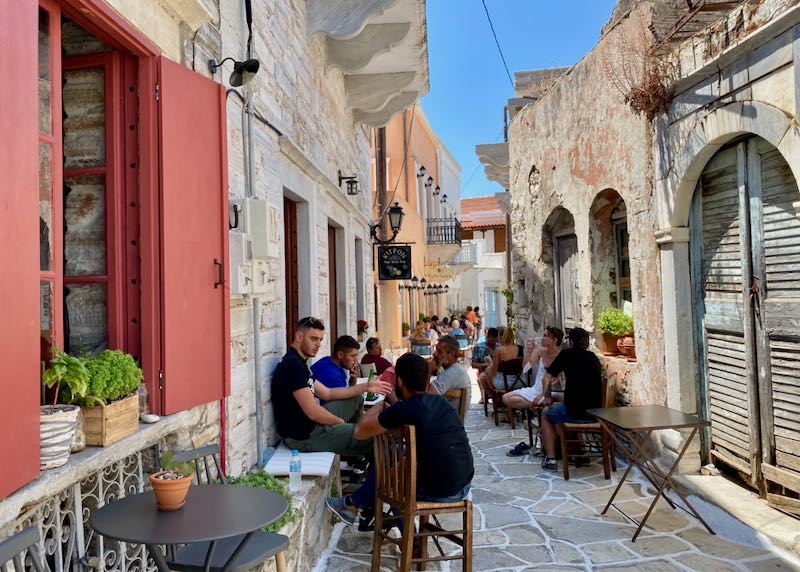

About Santorini Dave